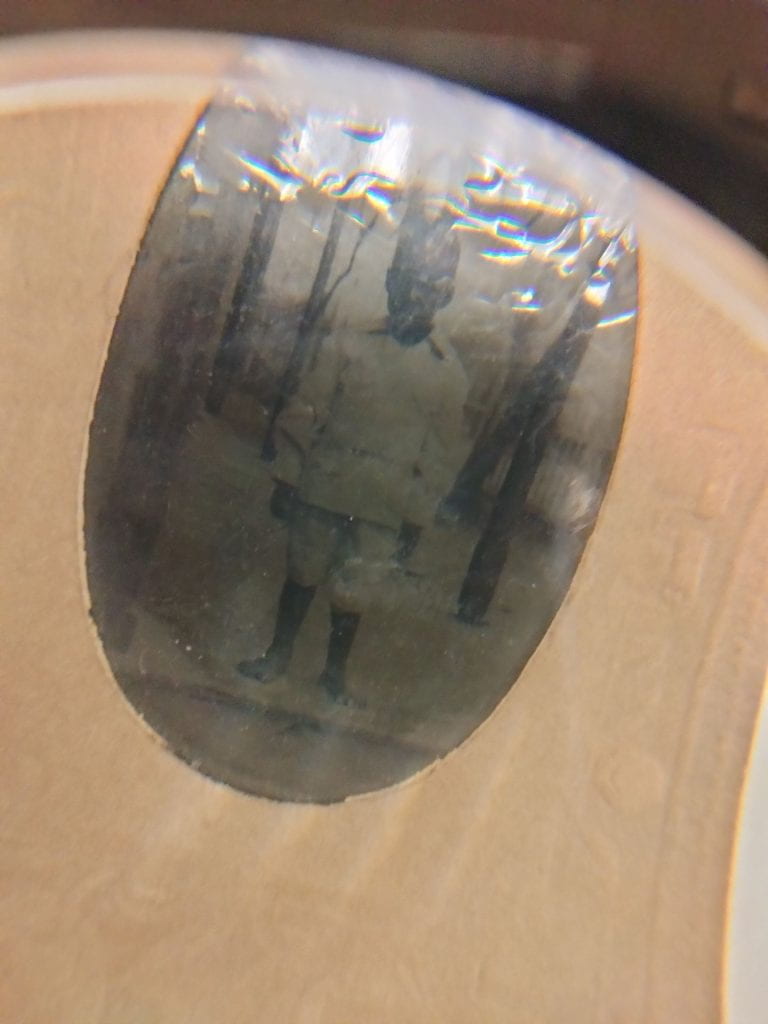Living in the digital age, I am not used to thinking of photographs as objects. I most commonly encounter photographs as images on a phone screen or computer monitor. While there are old photo albums at my parents’ house, they have spent the past ten or so years stacked together on a bookshelf in the living room, dusty and untouched. It is easy to forget that a photograph can be both an image and an object.
When I encountered Portrait of a child standing outside in the special collections reading room at the University of Delaware, I was struck by the materiality of this badly damaged tintype. Struggling to make out the image of the child — likely a young boy — due to the cracking and warping affecting the surface layer of the photograph, I could not help but pay attention to the photograph as an object. Tilting the photograph back and forth in my gloved hand, I observed how the light played over the uneven surface, distorting the image beneath. I peered into the murkiness of the child’s face, trying to discern a facial expression. Even the background is difficult to read. The subject appears to be standing on a porch, but the looming vertical shapes of trees and columns are indistinct, as is the ill-fitting uniform the child wears.

Photographs — as I have recently learned — are not quite flat. All photographs have at least three layers — the support (usually metal or paper), the binder (a substance holding the dyes or pigments that create the image), and the image material (the aforementioned dyes or pigments). This tintype has a sheet iron support, probably coated with black lacquer (or japanned). I can feel the weight and solidity of the iron when I hold the tintype in my hand. On top of the support is the collodion binder. Collodion is a thick, syrupy solution invented in 1846 that acts as a binder and suspends tiny particles of silver. The areas with the highest concentration of silver particles are the brightest, while the darkest areas (where the black lacquer shows through) have the lowest concentration of silver. There might even be an additional layer of varnish added on top of the collodion-and-silver layer.
Without taking this tintype into a conservation lab, it is difficult to say what exactly happened to this photograph. However, photograph conservator Debra Hess Norris has suggested that the cracking seen on this object may have to do with the properties of the iron plate lurking beneath its surface. The formation of rust on the iron plate might have disrupted the layers above, resulting in the uneven surface that both fascinates and frustrates me.
It is difficult to capture the three-dimensionality of a tintype with the flat, digital image produced by a scan. The image on the left acts as a digital surrogate of the tintype offering visual information about the object. It is an abstraction of the material thing it represents. However, inspired by Wendel White’s Manifest project, I have tried to recreate my experience with this photograph for you in a series of still images taken with my phone.1 As White powerfully expresses through his series of photographs of objects related to Black life in America taken in archives, the top-down, evenly lit photographs we may be used to seeing on museum websites or in museum catalogs are not an expression of how we see and interact with objects in everyday life — whether in a reading room or our own homes. Photographs are layered multimedia constructions that have weight and mass, that look different under different lighting and at different angles. They have fronts, backs, and sides. They also age, developing wrinkles and discoloration that speak to their long lives.
In the photographs shown below, I hope I can offer a glimpse of my own subjective experiences with this tintype and reveal just how dynamic this object is. Comparing these images to the scanned digital surrogate of the tintype shown above, what visual information do we gain? What do we lose?





Sources:
1 Wendel White, “Manifest,” accessed December 4, 2023, https://wendelwhite.com/projects/manifest/.

